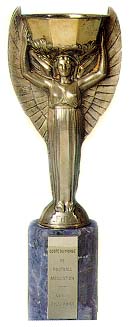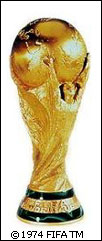| Origin
of the FIFA World CupTM
Trophy.
There have
actually been two FIFA World Cup(tm) trophies
made during the lifetime of the games.
The original trophy was made by a French
sculptor, Abel LaFleur, in gold. This sculpture
was of the Lady of Victory stretching both
arms out to support an eight-angled cup
on a marble-like base. This trophy was called
the "Jules Rimet Cup", in honor
of the founder of the FIFA World Cup(tm)
event. During the course of three FIFA World
Cup(tm) events (1930, 1934 and 1938) which
were held before the Second World War, the
name changed to simply the 'World Cup'.
This trophy has had an interesting history.
During the Second World War, it was hidden
from the Germans under a bed in an Italian
home. After surviving World War II, the
"World Cup" was stolen during
a public exposition just before the 1966
England FIFA
World Cup. Fortunately, the trophy was later
found in a trash container by a dog called
"Pickles." The Brazilian team
won the trophy permanently in 1970, and
was rewarded for being the only team ever
to have won three World Cups.
Unfortunately, the trophy was stolen a second
time in 1983 in Brazil and since then has
never been recovered. It is assumed that
the thieves melted down the trophy. The
Brazil Football Association now has a duplicate
of the trophy.
A second trophy was selected in 1974 by
FIFA. There were 53 designs to choose from.
The Italian sculptor, Silvio Gazazniga won
the commission. He designed this trophy
in 18 carat gold. The sculptor explained
that "players are supporting the earth
from the bottom on a circle form, which
represents the emotional moment of winning
the game."
More
on the FIFA World CupTM
trophies
The
French sculptor Abel Lafleur was honoured
to design the first World Cup trophy, the
Jule s
Rimet Cup. It was a gold statuette weighing
about 3,8 kilograms and was about 35 centimeters
tall, representing an allegorical winged
victory on an octagonal base. This famous
trophy was first stolen at an exhibition
in London prior to the 1966 World Cup, but
it was found by a dog named Pickles under
some bushes outside London shortly after.
In 1930 they said the first nation to win
it three times would keep it forever. When
Brazil won their third title in Mexico 1970,
they won permanent possession of it. In
1983 it was stolen again, and to this day
it has not been recovered. s
Rimet Cup. It was a gold statuette weighing
about 3,8 kilograms and was about 35 centimeters
tall, representing an allegorical winged
victory on an octagonal base. This famous
trophy was first stolen at an exhibition
in London prior to the 1966 World Cup, but
it was found by a dog named Pickles under
some bushes outside London shortly after.
In 1930 they said the first nation to win
it three times would keep it forever. When
Brazil won their third title in Mexico 1970,
they won permanent possession of it. In
1983 it was stolen again, and to this day
it has not been recovered.
The
present trophy, the FIFA World Cup (tm),
weighs about 5 kilograms and is 36 centimeters
tall. It was introduced to the 1974 World
Cup and is made of solid gold and malachite.
It is made by the Italian sculptor Silvio
Gazzaniga. He described his creation thus:
"The lines spring out from the base,
rising in spirals, stretching out to receive
the world. From the remarkable dynamic tensions
of the compact body of the sculpture rise
the figures of two athletes at the stirring
moment of victory".
This
FIFA World Cup(tm)trophy cannot be won outright
as the regulations state that it shall remain
FIFA's own possession. The FIFA World Cup(tm)
winners retain it until the next tournament
and are awarded a replica, gold-plated rather
than solid gold.
With
the Jules Rimet Cup now in the permanent
possession of Brazil after their third FIFA
World Cup™ triumph in Mexico City in 1970,
FIFA commissioned a new trophy for the tenth
FIFA World Cup™ in 1974. A total of 53 designs
were submitted to FIFA by experts from seven
countries, with the final choice being the
work of Italian artist Silvio Gazzaniga.
He
described his creation thus:  "The lines spring out from the base,
rising in spirals, stretching out to receive
the world. From the remarkable dynamic tensions
of the compact body of the sculpture rise
the figures of two athletes at the stirring
moment of victory".
"The lines spring out from the base,
rising in spirals, stretching out to receive
the world. From the remarkable dynamic tensions
of the compact body of the sculpture rise
the figures of two athletes at the stirring
moment of victory".
The
current FIFA World Cup™ Trophy also cannot
be won outright.
The
new FIFA World Cup(tm) trophy is 36 cm high,
made of solid 18-carat gold and weighs 4,970
grammes. The base contains two layers of
semi-precious malachite and has room for
17 small plaques bearing the name of the
winners - space enough for the World Champions
up to the year 2038.
|
